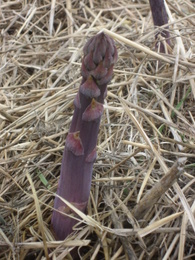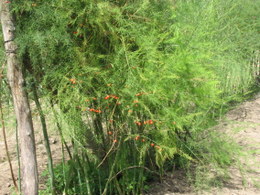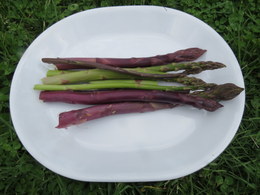Asparagus Growing Guide
Asparagus (Asparagus officinalis) is a perennial and will be in the location you choose for a long time. It is hardy in USDA zones 2 to 8 and prefers a neutral pH around 6.5 to 7.5. It is also is considered to be a deer-resistant plant, but deer and many other animals may eat the new shoots. Fencing and row covers will help protect the spears we all love.
It does best in full sun, but can tolerate part sun. It will grow 5 to 9-feet high and spread 2 to 2.5-feet wide.
It is one of the first vegetables we can enjoy in the springtime. It is very easy to grow and requires very little care. The most common spears are light green, but there are varieties with purple spears.
Your plants will be in this location for 20 or 30-years so be sure that it will have full sun now and in the future. Look out for any trees to the east, south and west. If there are any trees that grow taller and cast a shadow and they are on your property you can trim or remove them. If the trees are not on your property you will not be able to do much about it.
The crowns grow as male and female plants, which affects the production of spears. Male crowns produce more spears because the female crowns put some of their energy into making seeds.
If at the end of the season you see red berries on some of the plants, that is an indication that you have an older heirloom variety with female plants. Some gardeners will remove the female plants and replace them with a male plant to increase production of spears.
Soil Preparation
Asparagus will grow best in good loose organic garden soil. As soon as the soil is frost-free and can be worked, till the soil by digging down 8 to 12-inches turning the soil over with a garden fork. Remove any large rocks and stones. The small stones remaining will do no harm and actually benefit the soil by adding some micronutrients to the soil.
They do not like very acid soil and prefer a neutral pH around 6.5 to 7.5. Do a soil test and correct it if necessary. Your local Cooperative Extension can be very helpful in making recommendations.
Planting Asparagus
A good estimate is that a family of 4-will need 32 to 40-of the older standard varieties or 25-of the newer all-male hybrid plants. These all-male “Jersey” hybrids will produce almost 2 to 3-times as many spears per plant because they do not waste energy producing seeds.
Follow the grower’s instructions. They should be planted 3 to 4-weeks before your last frost date while the ground is still cold.
In general, dig a trench 6 to 12-inches deep. Place the roots 18 to 24-inches apart and then cover with enough soil to cover the roots, right up the crown. As the growing shoots emerge cover with more soil until the trench is filled back up.
Space the rows 2-1/2 to 3-feet apart to insure that the plants get enough air circulation.
Watering and Care
Weeds are the main enemy so make sure that the entire bed is weed free. As the spears emerge keep pulling weeds out and apply a nice loose mulch of shredded leaves or pine straw around the spears. This will keep the weeds out, the soil cooler and help retain moisture. During dry spells give some water each week.
Harvesting
Let your plants get established the first year and begin a light harvest the second year. Letting the plants get established will pay off in the coming years.
The first year, if you cannot wait, you can harvest 2 or 3-spears from each plant for about 2-weeks.
During the second year you can harvest for 3-weeks and in the following years you can harvest for 4 to 6-weeks.
Asparagus spears should be harvested when they are 5 to 7-inches high, while the tips are still tight. You can cut them with a knife or snap them off just above the soil level. The remaining stubs will not harm the plant. Snapping the spears has the benefit of getting the tender non-woody portion of the spear. If any tips are starting to loosen and open up leave them alone and let them grow.
After the end of the harvesting season let the spears grow up and produce the fern-like leaves, which are necessary for the growth of a strong root system. Keep mulching and removal of any weed growth.
It is important to let them grow until the first killing frost. The best time to cut back your asparagus is after the first frost.
Diseases
Fusarium wilt, crown rot and rust are occasional problems that usually occur if there is not enough if the plants are too crowded and there is not enough air circulation around the plants. Diseased plants including the roots and surrounding soil should be put in the trash, not the compost pile.
Use disease resistant varieties in the future and increase air circulation around the plants.
Pests
Aphids and asparagus beetles are an occasional problem. Hand picking the beetles with tweezers is one method.
Another is to use a spray of water to knock off the beetles and aphids. While the plant is wet apply a liberal dusting of diatomaceous earth (DE) to all sides of the plant and leaves. This will help the DE to stick to the plant which will kill the pests. Placing some DE around the base of the plant will help keep aphids from crawling back up the plant.
Be sure to use the food grade DE that is sold in garden centers. Do not use the DE that is used in swimming pool filters which has been chemically treated.
If you have a serious infestation on a large bed, you should check with your local Cooperative Extension for the insecticide that is approved for your area.
After the first hard frost the dead leaves and stalks should be removed and tossed in the trash, not the compost pile. This will help remove any over-wintering pests and their eggs.
Popular Varieties
The older standard varieties such as Mary Washington and Martha Washington produce male and female plants. The male plants produce more spears than the female plants. The female plants produce small red berries which contain many seeds. The seeds can be saved from the berries and planted, but it will take several years before you can begin harvesting any spears.
For higher yields all male hybrids such as Jersey Giant, Jersey King, Jersey Knight Jersey Centennial and Jersey Supreme will produce more spears. Due to research done by Rutgers University in New Brunswick, New Jersey they all have “Jersey” as part of their name.
For purple spears such as Pacific Purple and Purple Passion, you will find all male hybrids as well as heirloom male and female varieties. When cooked the purple color fades, but they have a slightly sweeter taste.
Sources: Seeds Now, Burpee, Gurney's Seed and Nursery
Garden Spikes newsletters give you timely information once or twice a month. Subscribe Free to the Garden Times newsletter below.
Your email address will only be used to send you a newsletter and will never be sold. You can unsubscribe at any time.



